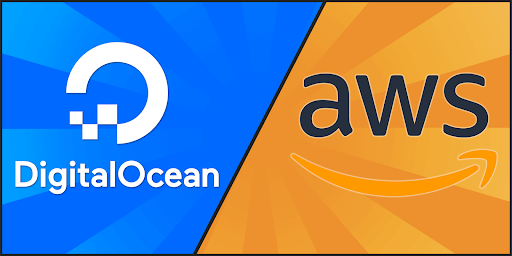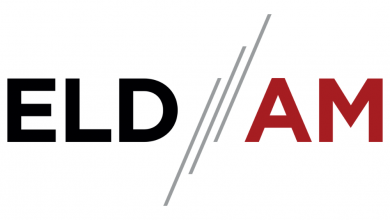Digital Ocean vs. AWS: Which Cloud Provider is The Best for You in 2025?

Introduction
If you’re deciding between DigitalOcean vs. AWS, this guide can help you choose the best cloud platform for your needs. AWS is a cloud leader that powers major companies like Netflix and NASA with a wide range of services. DigitalOcean, on the other hand, is known for its simplicity and cost-effective pricing, making it a popular choice for developers and startups.
To explore a detailed comparison and see how each platform can fit your specific needs, check out our full article.
AWS: An Overview
Amazon Web Services (AWS) is one of the biggest names in cloud computing. It provides a wide range of tools and services that help businesses build, run, and manage applications in the cloud. Whether you need infrastructure, software, or development platforms, AWS has everything you need to get started and scale as you grow.
AWS also offers:
- Amazon EC2 for launching virtual instances
- Elastic Beanstalk for app deployment
- S3 & Glacier for secure storage
- RDS, RedShift, DynamoDB, and SimpleDB for databases
AWS operates the largest data centers globally, ensuring reliable, fast access to services. It also serves government agencies through GovCloud, for example, a cloud built specifically for the US government, a high-security cloud environment.
AWS remains the leading choice for enterprises due to its competitive pricing.
Over the past two years, AWS has made 44 price reductions, making its services more affordable compared to other cloud providers like Microsoft Azure and Google Cloud.
DigitalOcean: An Overview
DigitalOcean, founded in 2011, has rapidly emerged as a top cloud hosting provider, catering specifically to developers’ needs. Unlike AWS, which caters to all industries, DigitalOcean offers a simple, affordable platform with high-performance virtual machines.
DigitalOcean’s main advantages are affordable pricing, high-performance machines, and ease of use. Its pricing starts at $0.007/hour or $5/month with no hidden fees. It supports popular Linux distributions like Ubuntu, CentOS, and Fedora, allowing quick deployment of apps such as WordPress and Docker.
The platform features SSD storage, 1 Gbps network speeds, and 55-second droplet startup times, often outperforming AWS in performance tests. DigitalOcean’s user-friendly interface and simple setup make it ideal for developers. While it started with basic IaaS services, it now includes load balancing, analytics, and hosted databases.
Although not as feature-rich as AWS, DigitalOcean remains a top choice for developers looking for a straightforward, affordable cloud platform.
DigitalOcean vs. AWS: A Detailed Comparison
Let’s compare DigitalOcean VS. AWS in detail on key parameters, such as pricing, security aspects, and more.
-
Pricing Structure
Both AWS and DigitalOcean primarily use on-demand pricing. AWS offers more flexibility with reserved instances (long-term savings) and spot instances (low-cost spare capacity). DigitalOcean focuses on simpler, predictable pricing for its services.
For a comparison between DigitalOcean and AWS pricing, see the table below.
| Configuration Example | AWS | DigitalOcean |
| VM Small | $7.49 / mo (t3.micro, 1 GiB RAM, 2 vCPU) | $6.00 / mo ( 1 vCPU, Basic, 1 GiB RAM) |
| VM Medium | $119.80 / mo (t3.xlarge, 16 GiB RAM, 4 vCPU) | $48.00 / mo (8 GiB RAM, 4 vCPU, Basic) |
| VM Large | $248.20 / mo (8 vCPU, 16 GiB RAM, c5.2xlarge) | $168.00 / mo (8 vCPU, CPU-Optimized, 16 GiB RAM) |
| Block Storage | $8.00 / mo (100 GB) | $10.00 / mo (100 GB) |
| Object Storage | $24.63 / mo (1 TB) | $20.00 / mo (1 TiB) |
| Load Balancer | (Network Load Balancer) $22.57 / month | $12.00 / month |
| Managed PostgreSQL | $57.59 / mo (4 GiB RAM, 2 vCPU, 50 GB storage) | $60.00 / mo (2 vCPU, 4 GiB RAM, 60 GB storage) |
| Serverless (25M Executions) | $36.26 / mo (512 MB RAM, 25M invocations) | $34.69 / mo (25M invocations, 512 MB RAM) |
| Free Egress Allowance | 100 GB / month | 1 TB of egress beyond allowance |
| AWS GPU (g5g.xlarge) | $0.42 / hr (1x T4G, 16GB VRAM, 4 vCPUs, 16GB RAM) | – |
| DigitalOcean GPU (Nvidia H100 SXM) | – | $3.39 / hr (1x H100, 80GB VRAM, 20 vCPUs, 240GB RAM) |
-
Security Features
DigitalOcean Security Features
DigitalOcean offers simple, strong security that works well out of the box. It’s easy to use, especially for startups and small teams.
- Shared security model: DigitalOcean protects the infrastructure. You handle your app, data, and user access.
- Data encryption: DigitalOcean encrypts all stored data using a secure method called LUKS. You can also easily set up a secure website connection (SSL/TLS) with Let’s Encrypt, a free tool that automatically provides SSL certificates.
- Network security: Cloud Firewalls stop unwanted traffic. You can keep your apps private by placing them in a secure network space called a Virtual Private Cloud (VPC).
- IAM (Identity and Access Management): You control who can do what using team roles, project-level permissions, two-factor authentication (2FA), and secure API tokens.
- Compliance: DigitalOcean follows major security and privacy standards like SOC 2 Type II, SOC 3, and CSA STAR Level 1. These standards help build trust, especially for regulated industries.
- DDoS protection: DigitalOcean automatically protects your apps from common internet attacks that try to overwhelm servers. This helps keep your services running with 99.99% uptime.
- Security tools: For secure access, you can use tools like SSH key management. DigitalOcean also offers ready-to-use, pre-secured app setups in its Cloud Marketplace.
AWS Security Features
AWS offers powerful, enterprise-level security tools. It’s great for large businesses with strict security needs.
- Shared security model: AWS secures the infrastructure. You control everything above that layer.
- IAM: AWS IAM gives detailed access control. It supports multi-factor authentication (MFA) and links with company login systems.
- Encryption: AWS offers tools like KMS, CloudHSM, and Certificate Manager to manage keys and SSL/TLS.
- Network security: Use Security Groups, Network ACLs, AWS WAF, Shield (for DDoS), VPC Flow Logs, CloudTrail, GuardDuty, and Inspector.
- Compliance: AWS follows strict rules like ISO 27001, PCI-DSS, SOC 1/2/3, GDPR, HIPAA, FedRAMP, and FIPS 140-2.
- Advanced tools: AWS offers services like Macie (for sensitive data), Secrets Manager (for secure storage), and AWS Identity Center (for access control).
-
Ease of Use
Both AWS and DigitalOcean allow you to scale your applications easily, but they do so in different ways.
AWS offers many features that can help you scale your application. However, with so many available options, the process can feel overwhelming. Configuring and managing AWS requires more technical knowledge, making it more suitable for teams with specialized skills. Leveraging AWS managed services can simplify the process. Additionally, opting for professional management services can make AWS adoption effortless.
DigitalOcean, on the other hand, concentrates on simplicity. The platform is built to be user-friendly and easy to navigate. You can quickly scale applications by adding servers (Droplets) and balancing traffic, all with an intuitive control panel or command-line tools. DigitalOcean’s straightforward approach is ideal for small teams or developers who prioritize simplicity over complexity.
-
Data Center Locations and Services Offerings
AWS
AWS Location
AWS is a global leader with the largest network of cloud data centers around the world. These data centers are spread across multiple regions to provide high availability and fast access for users across the globe. Some of the major AWS regions include:
- Asia Pacific: Singapore, Sydney, Mumbai, Seoul, Tokyo
- North America: N. Virginia, Ohio, N. California, Central Canada, Oregon
- South America: São Paulo
- Europe: Ireland, Frankfurt, London
- China: Beijing (offered through local partners due to regulations)
Note: AWS operates in China through local partners because of government rules. This is crucial for companies planning to offer services in China.
AWS Product Offering
AWS provides an extensive suite of cloud products and services across multiple domains. Some of the widely used services include:
Compute: EC2, Lambda, Elastic Beanstalk, Auto Scaling, Lightsail
Storage: S3, EBS, Glacier, Storage Gateway, FSx, Backup
Databases: RDS, DynamoDB, Aurora, Redshift, ElastiCache, Neptune
Networking: VPC, Route 53, CloudFront, Direct Connect, API Gateway, Global Accelerator
Security & Identity: IAM, Cognito, KMS, WAF, Shield
Monitoring & Management: CloudWatch, CloudTrail, Config, Systems Manager, Trusted Advisor
Analytics: Kinesis, Athena, QuickSight, EMR, Data Pipeline
DigitalOcean
DigitalOcean Location
DigitalOcean has fewer data centers but still maintains a strong global presence, especially for developers and small businesses. Its data center locations include:
- Europe: Amsterdam (AMS2, AMS3), Frankfurt (FRA1), London (LON1)
- Asia: Bangalore (BLR1), Singapore (SGP1)
- North America: Toronto (TOR1), New York (NYC1, NYC2, NYC3), San Francisco (SFO1, SFO2)
DigitalOcean Product Offerings
DigitalOcean offers a simpler yet efficient product range tailored for startups and small businesses. Key services include:
Compute: Droplets, App Platform, Functions
Storage: Spaces, Volumes, Backups, Snapshots
Databases: Managed PostgreSQL, MySQL, Redis
Kubernetes: DigitalOcean Kubernetes (DOKS)
Networking: Load Balancers, Floating IPs, Cloud Firewalls, VPC, DNS
-
Support Plans
AWS Support Plans
AWS offers four support plans: Developer, Business, Enterprise On-Ramp, and Enterprise, each tailored to different levels of AWS usage and criticality. These plans provide a range of services, including response times, architectural guidance, proactive programs, technical account management, and more.
Developer
Best for: Experimenting or testing in AWS
Pricing:
- Minimum: $29/month
- Or 3% of monthly AWS charges, whichever is higher
Key Features:
- Response times: General guidance < 24 hrs, System impaired < 12 hrs
- Architectural guidance: General guidance
- Self-service access: Use automation tools (AWS Support) for basic support tasks
- Support: Access to Cloud Support Associates during business hours
- Included Benefits: Billing support, AWS Support API, and basic Trusted Advisor checks
Business
Best for: Production workloads in AWS
Pricing:
- Minimum: $100/month, or
- 10% of AWS usage billing for the initial $0–$10K
- 7% for $10K–$80K
- 5% for $80K–$250K
- 3% over $250K
Key Features:
- Response times: Includes Production down < 1 hr
- Architectural guidance: From contextual to use cases
- Self-service access: Access AWS Support and Premium Support workflows for handling issues and requests
- AWS Countdown Premium (add-on)
- Support: 24/7 access via phone, chat, and web; plus AWS Support App integration in Slack.
- Included Benefits: Billing assistance, full Trusted Advisor checks, prioritized response on AWS re: Post, Support API & third-party software guidance
Enterprise On-Ramp
Best for: Business-critical or production workloads
Pricing:
- Minimum: $5,500/month, or
- 10% of monthly AWS charges, whichever is higher
Key Features:
- Response times: Critical system issues are addressed within 30 minutes.
- Architectural guidance: Annual consultative reviews
- Self-service access: Use AWS Support + AWS Premium Support workflows
- AWS Countdown (1/year) included; Premium version optional
- Support: 24/7 access to Technical Account Managers (TAMs)
- Benefits: Full Trusted Advisor checks, prioritized re:Post, billing optimization
- Access to AWS re:Post Private (optional), AWS Managed Services (AMS)
Enterprise
Best for: Mission-critical business workloads
Pricing:
- Minimum: $15,000/month, or
- $15K for AWS charges up to $150K
- 7% from $150K–$500K
- 5% from $500K–$1M
- 3% above $1M
Key Features:
- Response times: Mission-critical system down < 15 mins
- Architectural guidance: In-depth, use-case-specific consulting
- Proactive programs: Reviews, workshops, deep dives
- Self-service access: Same workflows + AWS Countdown included
- Support: Dedicated Technical Account Manager (TAM)
- Benefits: Billing optimization, re:Post Private access, full Trusted Advisor checks, Incident Detection & Response (included in eligible AMS regions), AMS access for advanced cloud ops
DigitalOcean Support Plans
DigitalOcean offers four support tiers to cater to different user needs, ranging from general guidance to dedicated, mission-critical support.
Starter
- Pricing: $0/month
- Best for: General guidance and troubleshooting
- Response Time: < 24 hours
- Support Channels: Email
- Support Agents: Customer support team offering general guidance
- Additional Features: Product documentation, access to community Q&As, and technical articles
Developer
- Pricing: $24/month
- Best for: Teams handling development and test (non-production) workloads
- Response Time: < 8 hours
- Support Channels: Email
- Support Agents: Customer support team delivering entry-level help and guidance
- Additional Features: Faster response times compared to the Starter plan
Standard
- Pricing: $99/month
- Best for: Teams managing and running production workloads
- Response Time: < 2 hours
- Support Channels: Live chat and email
- Support Agents: Expert technical staff with deep knowledge of all products
- Additional Features: Monthly newsletter with product updates, best practices, and Marketplace recommendations
Premium
- Pricing: $999/month
- Best for: Enterprises handling critical applications and a wide user base
- Response Time: < 30 minutes
- Support Channels: Dedicated Slack channel, video calls, mail, and live chat
- Support Agents: Skilled technical professionals with expertise across all services
- Additional Features: Higher API limits, dedicated teams of business and technical advisors, monthly newsletters, and monthly customer reports.
AWS vs DigitalOcean: How to Select the Best Cloud Platform for Your Business Requirements
When choosing between DigitalOcean vs. AWS, it’s important to consider your specific needs regarding cloud services, scalability, storage, and AI capabilities, as highlighted in our detailed comparison section.
Cloud Services:
- DigitalOcean offers IaaS and PaaS for small businesses, developers, and startups.
- AWS provides IaaS, PaaS, and SaaS, supporting hybrid and multi-cloud deployments.
Customization:
- AWS provides over 200 instance types for precise workload optimization, but requires advanced skills to manage.
- DigitalOcean offers fewer, predefined Droplet types, focusing on simplicity and speed.
Storage and Bandwidth:
- DigitalOcean offers Spaces (object storage) starting at $5/month for 250 GiB.
- AWS offers flexible S3 pricing, with a free tier of 5GB storage and 15GB of data transfer out.
Global Reach:
- AWS has a larger global footprint, supporting multi-region backups, edge computing, and low-latency content delivery.
- DigitalOcean has 15 data centers, which may limit global scalability.
Cloud Hosting:
- DigitalOcean offers Cloudways, a managed hosting service with scaling and security features.
- AWS provides Lightsail, a VPS service with simple configurations for popular applications.
Vendor Lock-In:
- AWS offers hybrid and multi-cloud solutions, integrating with on-premises systems and different cloud platforms.
- DigitalOcean is focused on single-cloud solutions with no built-in hybrid support.
AI & Machine Learning:
- AWS excels with advanced services like Amazon SageMaker and specialized GPU instances for AI workloads.
- DigitalOcean offers GPU Droplets and third-party model integrations for AI and ML tasks.
Conclusion
- Choose AWS if you need extensive services, scalability, and AI tools. In the DigitalOcean vs. AWS comparison, consider leveraging AWS consulting services to help you choose the ideal cloud solutions for your business requirements.
- Choose DigitalOcean if you value simplicity, fast deployment, and cost-efficient solutions for smaller projects.
Author Bio
Chandresh Patel is a CEO, Agile coach, and founder of Bacancy Technology. His truly entrepreneurial spirit, skillful expertise, and extensive knowledge in Agile software development services have helped the organization to achieve new heights of success. Chandresh is fronting the organization into global markets systematically, innovatively, and collaboratively to fulfill custom software development needs and provide optimum quality.



